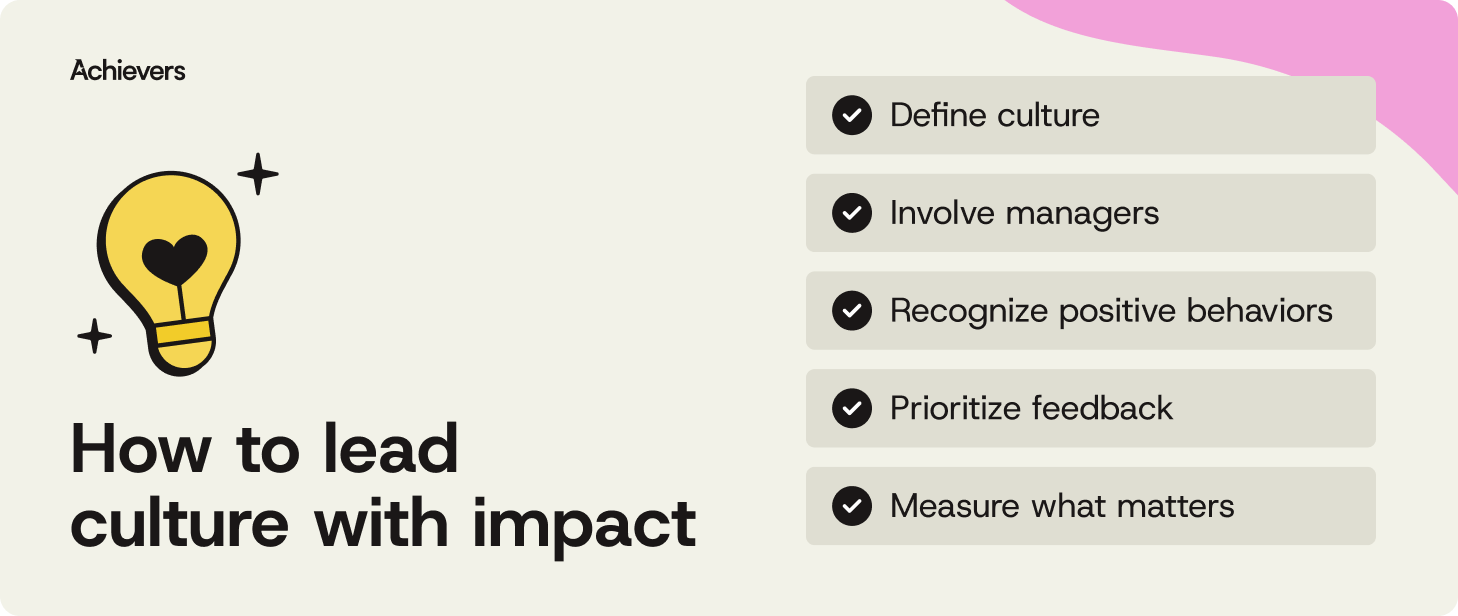Table of contents
Create a culture that means business™
Schedule a demo with an Achievers solution expert today.
What does your workplace culture actually feel like — not in theory, but in practice?
Not the mission statement. Not the careers page. The real culture. The one employees experience every day in 1:1s, team meetings, group chats, and project updates. And it matters more than you think. According to Achievers’ Engagement and Retention Report, culture and values fit is one of the top five reasons employees choose to stay or leave their current roles.
A strong workplace culture isn’t built on posters or perks. It’s shaped by daily behaviors, consistent recognition, and the kind of leadership that makes people feel seen. And when it’s working, you can feel it.
This blog is your playbook for building a workplace culture that sticks — one step, one behavior, one recognition at a time.
Let’s get into it.
How to turn workplace culture from intention to impact
If you want a workplace culture that feels real (not just aspirational), you need more than good intentions. You need a game plan. That means translating lofty ideals into everyday actions, recognizing what’s working, and making it easy for every team to lead with culture — not just talk about it.
Here’s how to build a culture people can truly feel, one step at a time:

Step 1: Define your culture
Every team says they value things like “collaboration” or “accountability.” But unless you’ve spelled out what those values look like on the ground, they’re just nice words in a handbook.
Start with asking the right questions:
- What does collaboration at work look like — especially when things get stressful?
- What does ownership sound like in day-to-day conversations?
- How do we want people to show up for each other, even when no one’s watching?
Then, turn them into specific, observable behaviors:
- Replace “be accountable” with: Follow through on commitments and own results — good or bad.
- Swap “be respectful” for: Give feedback directly, listen fully, and assume good intent.
Step 2: Equip managers to lead culture
Employees don’t just watch what leaders say. They watch what they do — how they run meetings, how they give feedback, how they handle tension or celebrate wins. That’s why culture has to be a team sport from day one, with great managers leading the charge.
To help them model the right behaviors:
- Give them clarity: Spell out what “living the values” looks like in their role.
- Offer real-world examples: How to run an inclusive meeting, how to recognize values in action, how to manage conflict with respect.
- Build habits, not just awareness: Use nudges, microlearning, or peer coaching to embed culture into how they lead.
Step 3: Recognize the behaviors that drive change
Culture gets stronger when people know their actions matter — and recognition is how you show them.
It’s meaningful feedback that reinforces the behaviors you want to see more of. When people feel seen and appreciated for how they work, they’re more likely to repeat those actions — and their peers take notice.
According to the Achievers Workforce Institute’s (AWI) State of Recognition Report, 91% of employees say they’d put in more effort if they felt valued. That’s your culture-building opportunity, hiding in plain sight.
To build recognition into your culture:
- Be specific: Call out the behavior and connect it to a core value.
- Be visible: Celebrate moments of impact in public channels or team meetings.
- Be inclusive: Make space for peer-to-peer recognition, not just top-down praise.
Step 4: Build a culture of feedback and listening
Want to know the fastest way to tank your culture? Ask for feedback… then do absolutely nothing with it.
Listening is how you show employees that their voices matter every day, not just during performance reviews or all-hands. And when it works? It works. AWI data tells us that employees who feel heard and see action on their feedback are 3.4x more likely to be engaged.
Here’s how to build a feedback flow that works:
- Keep it light: Use pulse surveys, quick 1:1 check-ins, or team retros. Don’t wait for a crisis — make feedback feel like part of the job.
- Always follow up: A simple “we heard you, here’s what we’re doing” can build more trust than a 30-slide culture deck.
- Make it a habit: Normalize upward feedback, close-the-loop moments, and real-time reflection. Culture grows in the little things — not the once-a-quarter offsite.
Step 5: Measure your culture’s impact
If you’re not measuring it, you’re just hoping for the best. And culture can’t run on vibes.
To really shape your workplace culture, you need to know what’s working — and what’s quietly going off the rails. That means tracking the signals that tell the real story, not just relying on intuition or the results of last quarter’s engagement survey.
Start with what matters most:
- Recognition trends: Who’s being recognized, how often, and for what behaviors? Are your values actually showing up in how people are celebrated?
- Behavioral adoption: Are employees following through on the norms and habits you’re trying to build?
- Sentiment over time: What’s the mood across teams — and is it shifting in the right direction?
And don’t just track — check in. Monthly or quarterly team-level “culture checks” give people a moment to reflect, share what’s changed, and suggest what’s next. It keeps culture from going stale and makes it easier to adjust before problems snowball.
Step 6: Celebrate the progress
Company culture doesn’t flip like a switch. It builds over time, through small wins, course corrections, and the occasional “well, that didn’t work.”
Perfect culture isn’t the goal. Visible progress is. And if you want people to keep showing up, you’ve got to recognize the effort — not just the end result.
Here’s how to celebrate in a way that keeps culture moving forward:
- Call out the firsts: A manager gives thoughtful feedback for the first time? Celebrate it. A team runs its first inclusive meeting? Shout it out.
- Track the shifts: DEI progress, improved check-in habits, more peer recognition — these are signs your culture is evolving.
- Make it normal: Progress isn’t always headline-worthy, and that’s okay. Normalize sharing “in progress” updates as part of how your team works.
Must-haves for creating a strong team culture
No matter the size of your company or the type of work you do, great workplace cultures tend to have a few key things in common. Think of these as the everyday ingredients that make your team a place people actually want to work.
- Shared values and behaviors: It’s not enough to say you value “collaboration” or “respect.” The strongest cultures turn those words into actions — clear, everyday behaviors that people can see, do, and recognize in each other.
- Psychological safety: Teams do their best work when people feel safe being honest. Psychological safety means it’s okay to speak up, ask questions, push back, and admit when something’s not working — without worrying about fallout.
- Leadership alignment: Culture falls apart when leaders say one thing but do another. When managers model the values they talk about — in meetings, in feedback, in how they show up — culture starts to stick.
- Open communication: No one likes working in the dark. Open, honest communication helps teams move faster, solve problems sooner, and stay aligned without constant second-guessing.
- Recognition and appreciation: A little “thank you” goes a long way. When people feel seen for what they’re doing — and how they’re doing it — they’re more likely to keep it up. Culture grows when recognition is part of the rhythm.
- Inclusion and belonging: People need to feel like they matter — and that they belong. Inclusive cultures don’t just invite different perspectives — they make space for them to thrive.
- Work-life respect: Burnout doesn’t build culture. Teams need space to breathe, unplug, and take care of life outside of work. Respecting that balance and supporting employee well-being helps them show up better when they’re on the clock.
From playbook to platform — how Achievers turns culture into action
You’ve defined your values. You’ve set the tone. Now comes the hard part: making it all stick.
The truth is that most organizations have a vision. What they’re missing is follow-through. Culture doesn’t live in mission statements — it lives in how people give feedback, celebrate wins, and how teammates show up for one another.
Achievers helps you turn that daily experience into a powerful lever for culture-building.
- Recognition in the flow of work: so positive behaviors are reinforced the moment they happen
- Manager tools and nudges: that help leaders model and support the culture you’ve built
- Real-time insights: into how values are being lived — and where you might be drifting off course
Culture doesn’t stick just because you had a great kickoff. It sticks when you’ve got the systems to back it up. Achievers makes it easy to recognize people in the moments that matter — and teams that do it regularly see 5x the engagement impact.
Lead the workplace culture your team deserves
Culture doesn’t just happen. It’s built, behavior by behavior, moment by moment. Whether it’s a thank-you, a tough conversation, or a team win that gets celebrated the right way, these are the things your people remember. And they add up.
The good news? You don’t have to leave it to chance.
With the right tools, you can make great culture easier to spot, support, and scale — one recognition, one conversation, one team at a time. Achievers helps turn those everyday moments into something bigger: a workplace culture people actually want to be part of.
Because your team deserves more than just values on a poster. They deserve a culture that shows up for them — just like they show up for you.



